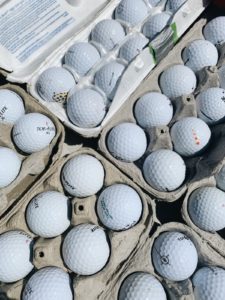Who Turned Off The Color?
Golf balls have undergone a number of changes and advancements over the course of the last two decades.
Innovation and technology has allowed companies to engineer golf balls that have very specific strengths, such as distance or accuracy. By weaving together several layers of different substances and tweaking their placement slightly, companies have created balls that are enhanced by the magic of science. A conscious observer may notice that the influx of science and technology in golf ball making inadvertently tapered off the presence of visual creativity, essentially causing the unceremonious death of the colored golf ball.
Many fans of golf were too young to remember or have simply forgotten about the use of colored balls on the PGA Tour in the late-1970s and early-1980s. The boisterous and jovial Wayne Levi won 12 times on tour in his illustrious pro golfing career, which was literally and figuratively highlighted by rolling a yellow-colored ball to a win at the Hawaiian Open in 1982. Levi outpaced Scott Simpson and the rest of the field, all of whom opted to use a white pebble. Thus marked the first time in the history of the PGA Tour that colored golf balls were rolled to a victory.
Not to be outdone, fellow PGA Tour member Jerry Pate upped the eccentric ante by opting to use orange golf balls on tour for the second half of the 1982 season and much of the 1983 campaign. A mere two months after Levi put yellow balls in the golden spotlight of success at the Hawaiian Open, Pate exposed his orange orb by to the bright lights of the PGA Championship, which he won by two strokes to famous 1980s runner-up Scott Simpson.
Balls that were brightly colored started to lose their luster by the middle of the 1980s.
The golfing world’s love affair with brightly colored balls began to fade, and throughout the 1990s, they were most commonly found in the bags of little old ladies. Unfortunately, little room exists within the PGA Tour for personal expression, and 100% of the pros on tour currently use white pearls. This is a bit surprising given that players such as Camillo Villegas and Ricky Fowler regularly adorn themselves in hats and shirts with patterns and colors that could startle a heroin addict.
Although tradition can be a powerful force, it seems to be only a matter of time before companies begin to put an extreme twist on the coloring of golf balls in order to please a generation that seeks out an abundance of visual stimulation. Aside from being visually pleasing, a colored golf ball can also have meaning. A tri-colored red, white and green ball could be a testament to Italian pride, while a red, white and black ball could allow a golfer to honor their Japanese roots.
One major roadblock to the reemergence of the colored golf ball is the notion that a colored or multi-colored ball could throw off a golfer’s concentration while they are standing over the sphere and preparing to strike it. Given the incredible skill levels of professional golfers and their innate ability to block out the surrounding world and focus on the task at hand, nobody should be surprised to see colored golf balls making a splash on the PGA Tour within the next few years.











Add comment
You must be logged in to post a comment.